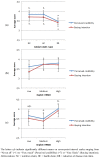Consumers’ health-related motive orientations and reactions to claims about dietary calcium
- PMID: 23306190
- PMCID: PMC3571639
- DOI: 10.3390/nu5010082
Consumers’ health-related motive orientations and reactions to claims about dietary calcium
Abstract
Health claims may contribute to better informed and healthier food choices and to improved industrial competitiveness by marketing foods that support healthier lifestyles in line with consumer preferences. With the more stringent European Union regulation of nutrition and health claims, insights into consumers' health-related goal patterns and their reactions towards such claims are needed to influence the content of lawful claims. This study investigated how consumers' explicit and implicit health-related motive orientations (HRMOs) together with the type of calcium-claim (nutrition claim, health claim and reduction of disease risk claim) influence perceived credibility and purchasing intention of calcium-enriched fruit juice. Data were collected in April 2006 through a consumer survey with 341 Belgian adults. The findings indicate that stronger implicit HRMOs (i.e., indirect benefits of calcium for personal health) are associated with higher perceived credibility, which is not (yet) translated into a higher purchasing intention. Consumers' explicit HRMOs, which refer to direct benefits or physiological functions of calcium in the body-as legally permitted in current calcium-claims in the EU-do not associate with reactions to the claims. Independently of consumers' HRMOs, the claim type significantly affects the perceived credibility and purchasing intention of the product. Implications for nutrition policy makers and food industries are discussed.
Figures
References
-
- Diplock A.T., Aggett P.J., Ashwell M., Bornet F., Fern E.B., Roberfroid M.B. Scientific concepts of functional foods in Europe consensus document. Br. J. Nutr. 1999;81:S1–S27. - PubMed
-
- Hasler C.M. Functional foods: Benefits, concerns and challenges—A position paper from the American Council on Science and Health. J. Nutr. 2002;132:3772–3781. - PubMed
-
- Williams P., Ghosh D. Health claims and functional foods. Nutr. Diet. 2008;65:S89–S93. doi: 10.1111/j.1747-0080.2008.00268.x. - DOI
-
- Bech-Larsen T., Scholderer J. Functional foods in Europe: Consumer research, market experiences and regulatory aspects. Trends Food Sci. Technol. 2007;18:231–234.
Publication types
MeSH terms
Substances
LinkOut - more resources
Full Text Sources
Other Literature Sources
Medical
Miscellaneous


